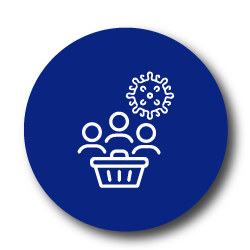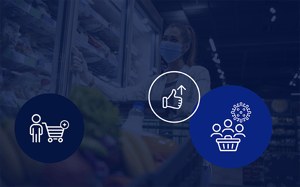The global COVID-19 pandemic has had a significant impact on consumers, their behaviour and ultimately their shopping habits. People around the world need to adapt to a new reality, such as changes in discretionary income and shopping priorities. These new personal circumstances drive changes in consumer behaviour, attitudes and shopping habits worldwide.
In this article, we explore the impact of the COVID-19 pandemic on consumer shopping behaviour. We also unpack why data-driven planograms play a critical role in any retail environment to meet consumer demand. Finally, we take a look at the benefits of data-driven planograms, both for the retailer and the consumer as the world continues to struggle with the Coronavirus.

How has COVID-19 changed how consumers shop?
The global COVID-19 pandemic has affected everyone’s lives and when people feel death is imminent, they panic.
The Coronavirus outbreak began in late 2019 and all of a sudden millions of people started panic buying. Retailer’s shelves were empty as both retailers and suppliers struggled to keep up with the drastic increase in demand for essential household goods, such as hand sanitizer items, tissue products and various food-related product categories.
The Coronavirus outbreak also caused global supply chains to be disrupted and therefore product availability has become a challenge. Consequently, consumers are now more inclined to buy cheap, alternative brands as some products remained unavailable during the lockdown.
For example, consumers would rather buy the hygienic body and hand washes, which are alcohol-based, instead of the usual fragranced body- and skincare products. Some consumers also exchanged brand loyalty for product categories that are readily available, such as toilet paper.
Due to many countries being in lockdown, most people are spending much more time at home. This causes certain product categories to be less in demand. Formal clothes, for example, that are suitable for an office environment have a lower demand. On the other hand, at-home (DIY) waxing, facial and grooming kits became more popular as the Beauty industry took a big knock and was closed down for a while.
Many people also had to face retrenchments or salary decreases and, as a result, consumers’ needs changed. Consumers have become increasingly price-sensitive and buy more selectively. They are now forced to adapt their purchasing habits to simply buying essential and basic foods, and other goods, that are both affordable and have a longer shelf life.
It is also worth mentioning that, due to the social distancing measures that have been put in place to limit the spread of the Coronavirus, e-commerce and online shopping has become an increasingly popular shopping method.
A recent study focusing on the impact of COVID-19 on consumer behaviour showed that 29% of South African consumers are more prone to doing online shopping from the comfort of their own homes. This helps consumers to limit their exposure in public places. However, on the other hand, it affects the retailer as foot traffic in stores decrease and consumers are less likely to do impulse shopping. This leads to reduced basket sizes and overall purchases, which makes retailers less profitable.
So, let’s take a look at how data-driven planograms can be used by retailers to meet the above changes in consumer demand.

What role does data-driven planogram generation play in meeting the changes in consumer demand caused by COVID-19?
Data-driven planograms can help you to allocate shelf space to products based on sales and syndicated data. It is a visual representation of how products should be merchandised on shelves to maximise sales and efficiency.
Data-driven planograms can be considered the link between yourself (the retailer) and the customer. Planograms can assist you in identifying the products that are high in demand due to COVID-19 induced demand. Ultimately, the purpose of data-driven planograms is to help you to identify and respond to changes in consumer behaviour by analysing sales and units data.
Changes in consumer demand result in changing consumer shopping behaviour, which ultimately leads to changes in category and product sales performance. When category sales increase or decrease, you must adapt the space allocation for the category accordingly. You can achieve this by generating new data-driven planograms based on the latest sales data.
Download our free Responding to Changes In Consumer Demand Ebook
Individual product performance will also be impacted by changes in consumer demand. This results in a need to revise and adjust category range plans and existing planograms to reflect the product positioning. Slower moving products are often displayed in non-prime positions and less space is allocated to them.
As mentioned previously, with the outbreak of COVID-19, consumers started stockpiling and panic buying staple and essential goods. You, as the retailer, can use metrics, such as days of supply (DOS) as well as sales and units performance data to identify your best performing product categories with the highest demand.
To meet your customer's demand, you need to revise and adapt product space allocations according to the metrics as discussed above. Depending on the average retail selling price, a specific product can have higher sales due to a high selling price but still show slow unit movement. In this case, you can decide to not increase the space allocated to these products. You would normally allocate more space to products with high selling quantities (units).
Days of supply refer to the number of days left before you will run out of stock of a specific product. Products with low days of supply are fast selling products that are high in demand, and therefore you must allocate more space to them. The opposite is also true - space needs to be reduced for products with higher days of supply since they are slow sellers. By calculating the days of supply, you can ensure that you have enough inventory of the products that are high in demand, and allocate more facings to these product categories.
DotActiv’s Category Management software has a Highlights Function which can help you to easily identify your best and poorer performing product categories in terms of DOS, % sales and % units. The shelf space allocated to the respective products can then be adjusted accordingly.

How will both the retailer and the consumer benefit from data-driven planograms during COVID-19?
Without data-driven planograms, you will not be able to identify product categories that are high in demand during the COVID-19 pandemic. The result would be out of stocks on fast selling lines, loss of sales due to customer dissatisfaction, and increased stock holding costs as a result of stocking slow-selling lines.
There are therefore many benefits of data-driven planograms for both the retailer and the consumer during COVID-19. The benefits of both the retailer and the consumer are interrelated as the benefit of the one is a result of another.
Let’s explore these benefits in more detail.
You, as the retailer, will benefit in the following ways:
Meeting the needs of your customers
With data-driven planograms, you can ensure that you have the right product assortments available in the right quantities to meet the needs and wants of your customers. This could also potentially result in increased foot traffic in your store, which will lead to increased sales, customer loyalty and increased profitability for the retailer.
Timely stock replenishment
Data-driven planograms can help you to replenish the stock in time to prevent out of stock of product categories that are high in demand during the COVID-19 pandemic. This will lead to increased sales, better profits and market share due to increased customer satisfaction.
Establishing trust and reliability at customers
You can establish trust and confidence by having the right stock available. This will help you grow your customer base and ensure loyal and returning customers.
[Ebook] Discover what goes into a Performance-Enhancing Planogram
The customer will benefit in the following ways:
A one-stop solution
Consumers are opting to buy all their groceries in one place to avoid too much contact with the public. Data-driven planograms help you to stock the right quantities of the right product categories which will provide your customers with a one-stop solution for all their grocery needs.
A satisfying shopping experience
If you make use of data-driven planograms to determine shelf layouts, your customers will be able to find all the products they are shopping for on the shelf. For the customer, this means increased product availability, a shoppable store due to data-driven planogram layouts and less time spent in-store looking for products.
Less panic buying
Data-driven planograms will ensure that essential and high demand products are readily available and always in stock. Hereby you can show consistent reliability in terms of product delivery to your customers. This will establish comfort and peace of mind for your customers and they will feel less inclined to panic buy staple products.
Conclusion
Fluctuating consumer demand during COVID-19 requires that data-driven planograms are regularly updated and implemented by retailers. This will help you to have better inventory control and to prevent over and understocking of products.
By analysing purchasing habits and sales and units data during the COVID-19 challenge, you are enabled to adapt your data-driven planograms (and product space allocations) to provide your customers with a satisfying shopping experience that meets and exceeds consumer demand.


